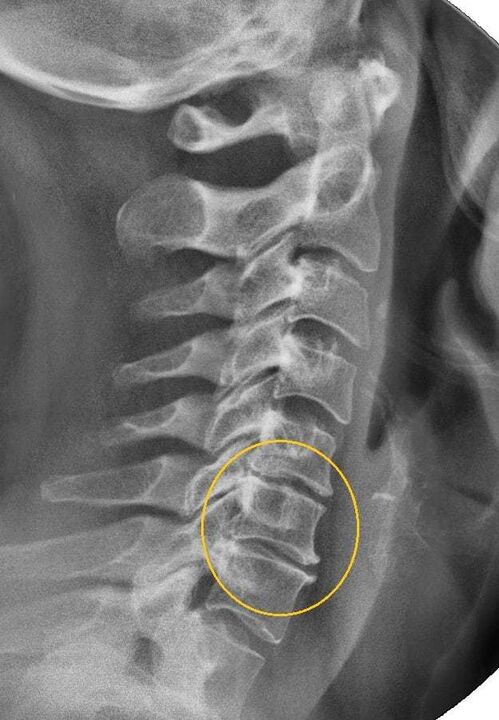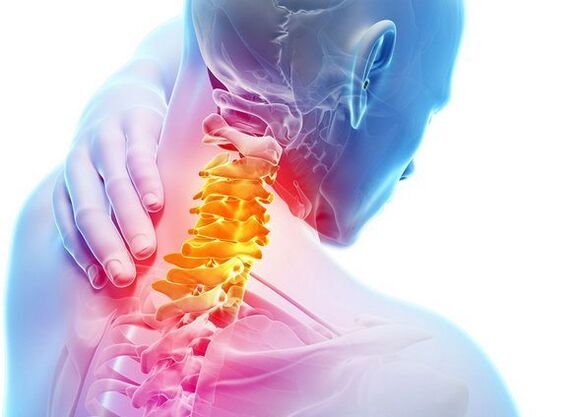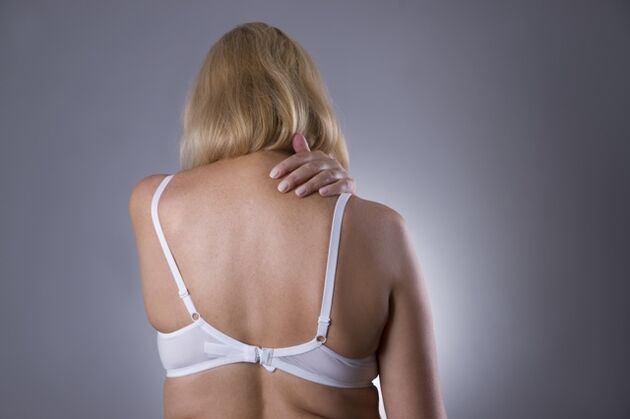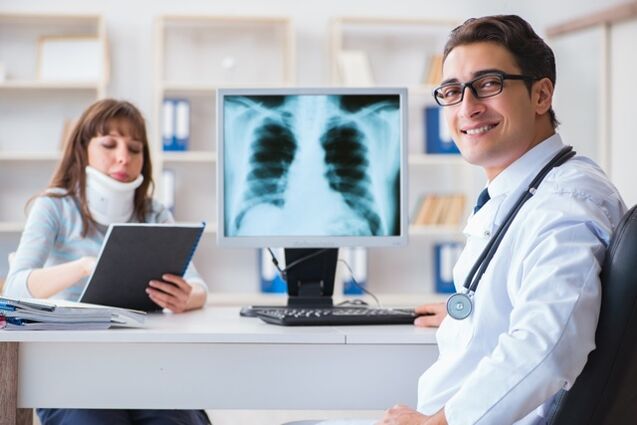Osteocondrosis is a common pathology of the spine, characterized by a dystrophic change in the structure of the cartilaginous discs of the vertebrae and their bone base.

In a sense or in the other, osteochondosis occurs in most people after 30 years. The symptoms of cervical osteochondosis are different, which often complicates the diagnosis and subsequent treatment.
The causes of cervical osteochondosis
In part in the development of the osteochondosis of the "guilty" neck, the disturbance of the modern person and the corresponding distribution of loads along the spine, as well as the natural processes of aging of body tissues, moreover, there are a series of provocatives the development and progression of this pathology:
- sedentary lifestyle;
- long stay in the same position during work;
- Excess body weight;
- injuries in the course of the spine in the neck;
- chronic stress, constant nervous tension;
- Regular hypothermia of the muscles of the collar area (for example, when it is close to the air flow by the air conditioner);
- Congenital vertebral anomalies and intervertebral discs.
General symptoms and signs of cervical osteochondosis
The osteochondro process simultaneously affects any of the spine. The lumbar and cervical vertebrae are more affected by pathologies, like the most susceptible to loads due to the anatomy of the human skeleton.
The consequences of the osteochondosis spinal in the cervical region cause the greatest inconvenience and potential complications, because the neck is an area rich in neuromusive highways, many of which directly feed the brain.
For this reason, clinical symptoms with cervical osteochondrosis are many associated with the ischemia of brain areas. In addition, the nerve roots, which provide the sensitivity and motor activity of the hands and the shoulder belt, when squeezing with destroyed vertebrates can give a variety of symptomatic paintings.

The signs of osteochondosis of the neck depend on which of the body systems are influenced by the pathology:
- Blood circulation interrupted due to the compression of the vertebral arteries determines most of the complexes of the symptoms from the brain.
- The compression of the roots that leave the vertebrates gives an image of the injury of the peripheral nerves.
- The pinch of areas of the spinal cord is associated with serious neurological pathologies found in advanced cases.
Below, consider the general clinic of the osteochondrosis of the cervical column.
Pain in the back of the head, neck and collar
This is the most common symptom. The location of the pain can be expanded, by hitting the shoulders, the region of the clavicle, the chest, the transformation into intense head heepsters.
The nature of pain depends on the location of the injury and the severity of the pathology. Initially, pain can be quickly transient, gradually becoming chronic, painful.
In times of exacerbations, the pain becomes shot, in an increased tone of the muscles of the neck and a limited movement of the head.
Often, pain with cervical osteochondrosis can be located behind the sternum, in which case many patients take this symptom for Angina Pectoris. Differentiation can be carried out by taking a nitroglycerin pill: the pain due to osteochondosis are not removed.
Noise, ring, feeling of congestion in the ears
These symptoms often join a decrease in hearing. These phenomena are associated with a decrease in blood flow from vertebral arteries to the vestibular apparatus.
The complex of these symptoms is called coclear syndrome or snail and is far from always determining its connection with osteochondrosis in the cervical region.
A specific feature for differentiation is that noise, congestion and ringtone in the ears are warned when changing the location, after a long stay in a position.
Dizziness
The dizziness are also due to the violation of the blood flow to the organs of the internal ear, which guarantees the balance of the body. Nystagm often combines vertigo - arbitrary fluctuations in the pupils of the eyes on the sides.

Missing aerial
This sensation appears due to the irritation of the ends of the diaphragmatic nerve. It is a component of the cervical nerve ray and is involved in the adjustment of breathing, in its depth and frequency. Patients complain of the inability to breathe in the fullest chest.
In some cases, the symptom worsens a serious lack of breath and suffocation. For the same reason, breathing stops at night and snoring.
The disadvantage of oxygen due to breathing problems is ultimately the cause of the increase in fatigue, a decrease in concentration and memory problems.
Nausea
It is accompanied by the healing air. Also due to problems with blood circulation in some areas of the brain and internal ear. The nausea is sometimes observed with an indomitable vomiting caused by the movements of the head and the body. The consequence of frequent nausea and vomiting is a decrease in appetite, weight loss, food failure.
Problems with vision
"Flies" in the eyes, a decrease in visual acuity, fog in front of the eyes: these are all the symptoms due to the ischemia of the brain area which is responsible for vision.
Patients with osteochondrosis complain less commonly from vision, since the lack of blood supply from vertebral vessels is compensated by the blood flow by the carbon arteries system.
Glasses and therapeutic gymnastics for the eye muscles do not solve the problem, usually the vision improves after the treatment of osteochdrosis.
Blood pressure advice
An unstable level of pressure is due to the compromise blood flow in the oblong brain which is responsible for the functions of the vascular-motor center.
Sudden state or syncopes
It occurs with the spasm of the brain arteries due to the short -term stop of the bloodstream along the vertebral arteries.
From the state of loss of the patient's consciousness, you can quickly be removed by throwing it so that the legs are slightly higher than the head: the blood flow to the brain allows a person to lead to life.
After a fainting attack, reversible problems with the word and movements can be observed for some time, due to a short stop of the bloodstream.

Green symptoms
It can often be the only sign indicating cervical osteochondosis. They are expressed as a sweat, dryness and feeling of a lump in the throat, difficulty with swallowing. The symptoms are associated with the compression of the nervous plexus responsible for the caking of the pharynx. It is necessary to differentiate these manifestations from a similar clinic in inflammation or neoplasms.
Lift the body temperature
The increase in body temperature for cervical osteochondrosis is not the most typical symptom, it is rarely and locally observed: in the cervical and collar area, with a slight redness of the skin.
The clinic of the osteocondrosis in the cervical column can first be of various degrees of gravity, depends on the stage of the development of the pathology, even during the periods of exacerbations they are brighter and, secondly, to form in some syndromes.
Symptoms depending on the stadium of cervical osteochondosis
Phase I.
The beginning of the degenerative processes in the cartilage of the vertebral discs. The symptoms are weak, sometimes it cannot be observed at all. The first signs of osteochondosis of the cervical column:
- discomfort in the neck, arms, shoulders, sometimes transforming into pain;
- heachache;
- Easy restriction of the motor activity of the neck;
- Passing the visual value quickly;
- Reduce the sensitivity of the skin of the collar area.
IMPORTANT: these symptoms become more pronounced when it inclines the head.
As a rule, in the first phase of the osteocondrosis of the cervical region, patients do not go to the doctor, believing that all the symptoms are associated with fatigue, stress, age, lack of sleep.
Phase II
In this phase, the protrusion of the vertebrates began, the intervertebral cracks were tightened, the fibrous collagen fiber of the disc on the disc is destroyed. There are evident painful symptoms of nature in one point due to the compression of the nerve trunks, which intensify during the neck movements and the curves of the head. Here you can already suspect cervical osteochondrosis, whose symptoms in the second stadium are as follows:
- pronounced neck pain, sometimes with a crunch;
- The skin of the shoulders and hands almost completely loses sensitivity;
- The headache is frequent, they do not go for a long time;
- Visual impairment with "flies" in the eyes;
- Ringua and noise in the ears;
- weakness of the muscles of the upper ends;
- The clarity of the reflections of the tendon is reduced;
- Shot of pain with dedication under the scapula;
- the feeling of a lump in the throat, problems with swallowing;
- Sleep disorders, usually insomnia.
The long tense in a position leads to severe pain. In this phase of the development of the disease, patients are already coming from the doctor to ask for help.
Phase III

The fibrous ring on the disc is destroyed, hernias are formed. In the third phase, there is a deformation of the spine, the movement and dislocation of the vertebrae due to their weak fixation. The symptoms are as follows:
- Intensive and acute pains in the neck, collar area, cardiac area;
- The sensitivity of the scalp on the back of the head, in the shoulder region, in the hands, until the complete absence of;
- hernia of the cervical column;
- Parents and paralysis of the upper ends;
- The tendon reflections are practically not observed.
This is a serious phase of the disease in which the patient is no longer able to support the head alone. The ischemia of the spinal cord and the compression of the arteries of the spine lead to paralysis and the paresis in other parts of the body and the spinal race.
Syndromes caused by osteochondosis of the cervical column
Not specific and a large number of various symptoms that accompany the osteochondosis of the cervical column make it difficult to diagnose and further treatments, since some of them can be a sign of completely different diseases. The symptoms of cervical osteocondrosis are trained in some groups called syndromes. Their presence and gravity can indicate a pathology in the cervical column with an updated location.
A group of syndromes frequently found:
Koreshka. Otherwise, called cervical root. It combines the symptoms associated with the violation of the nerve roots of the cervical vertebrae. The "goosebumps" in the affected area, finger tingling, forearms, skin of the skin, spread to some fingers are characteristic.
Irrelevant reflex. Arating and acute pains in the back of the head and neck, sometimes with the return to the chest and shoulder, which occurs at the time of the change of position of the head and neck, when sneezing, cough and an acute turn of the head.
The vertebral artery syndrome includes:
- headache, attacks or constantly, button in nature;
- discomfort in some movements, included after a long static position;
- weakness, nausea, loss of consciousness;
- Reduce hearing, balance problems;
- Reduce visual acuity.
Cardiac. Almost the same picture with Angina Pectoris often leads to improper diagnosis and treatment. The syndrome appears due to the irritation of the diaphragmatic nerve receptors, which partially fascinates the pericardium and a large chest muscle. Therefore, cramps in the heart region are more reflected, like a revision of the irritation of cervical nerves. Symptoms:
- Suddenly starting, prolonged pain, intensifying with a strong movement of the neck, cough, sneezing, not passing when taking heart drugs.
- ECG does not show an altered blood flow of the heart muscle.
- Sometimes there may be extrasisti and tachycardia.
Diabolical vegetative syndrome. Subluxus The first vertebra of the cervical departure with movement can lead to the development of vegetable-vascular dystonia. It is not a certain diagnosis of VVD, as it has no pronounced symptoms.
There may be neurological signs, symptoms of altered cerebral blood flow, intracranial pressure, muscle cramps.
Consequently, the patient's complaints are reduced to dizziness, a decrease in visual acuity, loss of consciousness, headache, nausea.
How to treat cervical osteochondosis
The state -described state of the spine is a very serious pathology, which, with abandonment, leads to disability and, following deep disorders of brain circulation - and death. For this reason, for cars -marization, if these symptoms appear, you shouldn't do it.
Osteocondrosis is treated in a hospital and home exclusively as a prescription.
In the initial stages, the treatment of cervical osteochondrosis is conservative, including drug prescriptions: non -steridal antimammator drugs, anesthetics, hormonal drugs, vitamin complexes, condroductors -all this relieves the influence, pain, improves the trophic of soft tissues.

In the acute period, the drugs are prescribed in the form of injections, since pain attenuates, the patient goes to the tablets. Physiotherapy, massage, exercises of exercises, usually prescribed in the remission phase, join the drug courses. In difficult cases, osteochondrosis is treated with surgery.
Prevention
The base of the health of the cervical column is a strong and healthy back, physical activity, a comfortable bed with anatomical cushions and mattress, adequate posture and proper nutrition.
It is worth avoiding neck lesions and weight lifting. It is necessary to combine prolonged sitting with rest periods and heat.
Forecast of recovery
The prognosis for a qualified and timely treatment is favorable, but much depends on the age of the patient, the severity of the manifestations and the stage of the disease. It is also important in which the person performs medical recommendations regarding nutrition, lifestyle and eliminates bad habits.
Conclusion
Therefore, in most cases, the osteochondosis of the cervical region can be treated. However, it is worth remembering that the disease can return at any time. To avoid this, it is necessary to observe prevention measures and a healthy lifestyle.
Also, it is worth remembering:
- The cause of osteochondrosis is difficult to establish.
- The symptom of the disease is pain in the back of the head and neck.
- Cervical osteocondrosis is treated completely: drugs (mainly fans), massages, operating therapy.
























